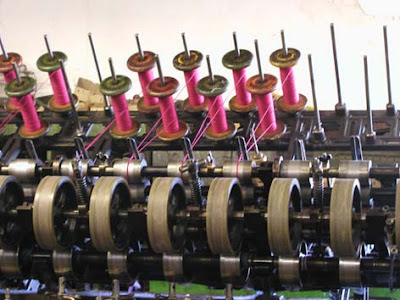A few years ago I went to Coldharbour Mill at Uffculme, near Collompton in Devon, and a fascinating trip it proved to be.
It had been in continuous use for the weaving of yarn from being built in 1799 until it was closed in 1981. It was re-opened in 1982 as a textile museum and is open to the public. We were lucky enough to go on a tour of the mill and see woollen yarn being made, from fleece to the finished knitting yarn. I don't know how often these tours take place, but Coldharbour Mill has it's own website so it would be easy to find out. The tour we went on consisted of four adults and a dog!
One of many baskets of bobbins in the mill
><><><><><><><
There is a shop at the site selling the finished yarn, as well as rugs and tartans, which I believe are also made on the premises.
><><><><><><><
The site is full of interesting industrial artifacts, enough engine-type things to keep the men interested, and a photographers dream. Good cafe too.
And while on the subject:-
The little bobbin block is one of my favourite patterns, which I love to combine with florally fabrics, most of these in the photos are Liberty lawn, although some other cotton lawns have sneaked in too.
The quilt below is the one I made first, and although it is very pretty, and actually contains more of my favourite Liberty lawn patterns I'm not so keen on the setting I used. At the time I used sashing for speed and to increase the size, but I wish I had not been so impatient.
I suppose the origin of the pattern shape was the old wooden cotton reels of my youth, as this is what they looked like in profile, I can't think that the modern plastic ones could inspire you, but who knows, I may soon be proved wrong.
It's quite a simple pattern to make. Basically four triangles, two of which are made of joined backing fabric and floral fabric, and the other two of just the floral fabric. Each of my little blocks is 4 1/2inches (12cms) square. If you cut an accurate square of paper or card, divide it diagonally then cut it into 4 pieces you will have the first piece of pattern. Then rule a line 1 inch (or 2.5cm) from the pointy end of one of the triangles, cut it and you will have two more pattern pieces. Draw round these pieces on your fabric, adding a quarter inch seam allowance and you can start to make your first block. This is one of the few patterns I like to sew by hand, I just keep working at them when I am in the mood, and if you are careful to add a regular seam allowance it's quite therapeutic. It makes an ideal scrap quilt.





No comments:
Post a Comment